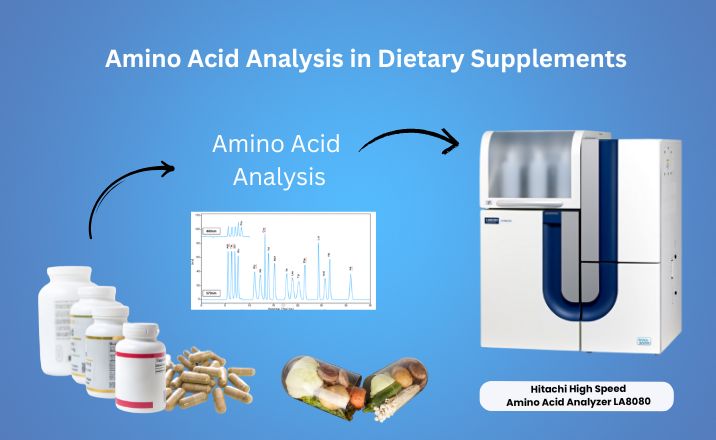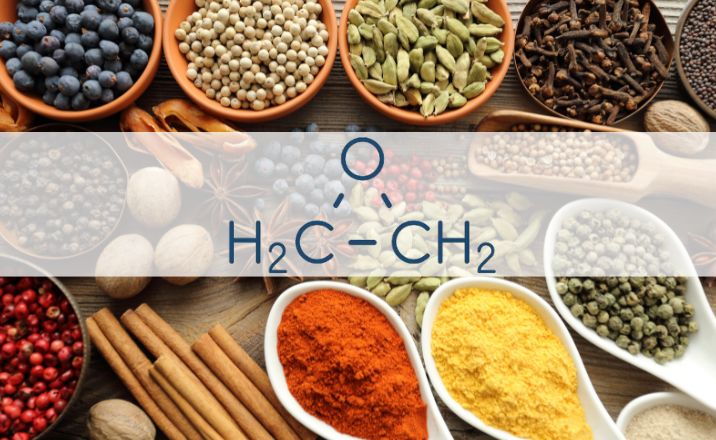Amino Acid Analysis in Dietary Supplements: The Science of Nutrition

Dietary supplements are legally defined as “products intended to supplement the diet, containing concentrated sources of nutrients or other substances with a nutritional or physiological effect” as per Section 22 of the Food Safety and Standards Act, 2006 [1]. Dietary supplements have become an essential fixture in many wellness routines, whether to cover nutritional shortfalls or to support targeted goals—like boosting immunity or increasing muscle mass. However, these products are not interchangeable across different lifestyles and needs. By exploring how amino acid analysis underpins both product quality and individualized nutrition, we can see why supplements must align with personal health objectives rather than relying on generic, one-size-fits-all formulas.
Why Consider Supplements at All?
Even the most carefully planned diet can sometimes miss the mark when it comes to essential nutrients. Hectic work schedules, specialized fitness goals, and certain medical conditions all contribute to nutritional gaps. Targeted supplements can make up for these shortfalls by supplying exact doses of vitamins, minerals, and amino acids—often in a more convenient manner than trying to meticulously reconfigure your entire daily meal plan.
Why Amino Acid Analysis Matters?
At the core of many dietary supplements are amino acids—the building blocks of proteins. They are vital for nearly every biological process, including muscle repair, immune function, and even mood regulation [2]. Dietary supplements fill nutritional gaps and support health goals, yet the industry faces issues like mislabeling, adulteration, and inconsistent quality. Amino acid analysis addresses these challenges by verifying supplement composition, ensuring accurate labeling, regulatory compliance, and product effectiveness
Amino Acids are divided into two categories:
Your body is an incredibly sophisticated system, but it cannot produce all the nutrients it requires. These are known as essential amino acids, which must be obtained through diet or supplements. In contrast, the body can synthesize non-essential amino acids on its own. Here’s a breakdown:
Essential Amino Acids (Must be obtained from diet or supplements):
- Leucine: The muscle-building powerhouse
- Isoleucine: Crucial for energy and recovery
- Valine: Supports muscle growth and tissue repair
- Lysine: Essential for immune function
- Methionine: Important for metabolism
- Phenylalanine: Helps produce other amino acids
- Threonine: Supports skin and immune health
- Histidine: Vital for tissue repair
- Tryptophan: The sleep and mood regulator
Missing these essential nutrients can impact overall well-being, and that’s where precise amino acid analysis ensures supplements deliver what they promise [2].
Quality Control: Why Amino Acid Analysis is Critical
The global dietary supplements market size was valued at USD 177.50 billion in 2023 and is projected to grow at a CAGR of 9.1% from 2024 to 2030. India alone is seeing a 16% – 20% growth annually [3]. However, this booming industry also faces challenges like mislabeling, adulteration, and inconsistent quality.
Amino acid analysis addresses these concerns by:
- Verifying composition: Ensures the product matches its label.
- Detecting adulteration: Uncovers harmful fillers or excess amino acids used to inflate protein content (e.g., amino spiking).
- Ensuring efficacy: Confirms that products deliver their intended health benefits.
Amino Spiking and Adulteration
One widespread issue is “amino spiking”—the addition of cheap amino acids to boost a product’s protein content artificially. Alongside mislabeling, some products may contain undisclosed fillers which are not essential for human health and compromise both safety and efficacy [4].
Case in Point: Citizen Protein Project Data Point
According to a recent (2024) Citizen Protein Project study, nearly 70% of protein powders tested were found to be either mislabeled or tainted with harmful toxins. This underscores how prevalent and dangerous adulteration is in today’s supplement industry—and why reliable amino acid analysis is indispensable for consumer protection [5].
The Hitachi LA8080 Amino Acid Analyzer is equipped to accurately detect and quantify a wide range of amino acids, including uncommon or inexpensive ones like glycine, aspartic acid, beta-alanine, creatine, gamma-aminobutyric acid, taurine, hydroxyproline, glutamic acid, and citrulline, often misused in protein spiking. Its advanced post-column derivatization ensures precise identification, safeguarding supplement integrity and consumer trust [6].
Global Regulations: Aligning Quality with Safety
Various regions uphold stringent regulations, but their shared purpose is to protect consumer welfare:
FSSAI (India) Guidelines for Health Supplements
- Nutrient Limits: Nutrient levels should not exceed the Recommended Dietary Allowance (RDA) established by the ICMR [7]. The amino acids included are:
| Sr. No. | Amino acids | RDA (mg/kg body wt./day) |
| 1. | Histidine | 12 |
| 2. | Isoleucine | 23 |
| 3. | Leucine | 44 |
| 4. | Lysine | 35 |
| 5. | Sulphur amino acids | 18 |
| 6. | Aromatic amino acids | 30 |
| 7. | Threonine | 18 |
| 8. | Tryptophan | 4.8 |
| 9. | Valine | 29 |
- Content Claims: Nutrient claims must meet at least 15% of the RDA; higher claims require at least 30%.
- Approved Ingredients: Only FSSAI-approved ingredients are allowed.
- Labeling & Claims: Labels must be accurate; disease-treatment claims are prohibited [8].
Personalized Nutrition: One Size Does Not Fit All
Age, fitness level, and medical history all influence the body’s nutritional requirements. An endurance athlete might need extra branched-chain amino acids (BCAAs) for muscle repair, while a senior may need higher amounts of leucine to combat age-related muscle deterioration. Choosing supplements that precisely reflect these varying needs is crucial—a task that heavily relies on accurate product labeling and quality control.
Advanced Technology: The Hitachi LA8080 Amino Acid Analyzer
For consumers and providers to trust a product’s amino acid profile, precision testing is non-negotiable. The Hitachi LA8080 Amino Acid Analyzer delivers highly accurate, reproducible results via post-column derivatization, making it invaluable for:
- Guarantees Accurate Labeling: Confirms whether the product truly contains the amino acids (and quantities) claimed on the label.
- Maintains Regulatory Compliance: Meets the requirements set by health authorities such as the FDA, FSSAI, and the EU.
- Validates Product Efficacy: Ensures that consumers receive the health benefits they expect, whether that’s muscle repair, immunity support, or enhanced energy.
Smart Buyer Checklist
- Scrutinize Labels: Look for a detailed amino acid breakdown that matches the stated protein content.
- Seek Third-Party Testing: Certificates of Analysis (COA) confirm purity.
- Verify cGMP Compliance: Ensures consistent quality.
- Be Wary of Red Flags: Overblown claims or very low prices may signal adulteration.
- Match Dosage to Your Goals: Ensure serving sizes align with your fitness or health requirements.
- Consult Professionals: Those with specific health conditions should get medical advice before choosing a supplement.
Conclusion: The Path Forward—Stricter Regulations and Scientific Excellence
As the demand for dietary supplements continues to rise, ensuring their quality, safety, and efficacy must be a top priority. Stricter regulations are essential to prevent misleading claims, adulteration, and substandard products that could compromise consumer health. Establishing well-defined regulatory frameworks will not only enhance transparency but also ensure that supplements deliver the promised nutritional benefits.
Advanced amino acid analysis, backed by cutting-edge technologies like the Hitachi LA8080 Amino Acid Analyzer, plays a pivotal role in maintaining the integrity of dietary supplements. By accurately quantifying amino acid content, detecting impurities, and verifying label claims, this analytical approach helps manufacturers comply with regulatory standards while boosting consumer confidence.
Furthermore, Centers of Excellence serve as innovation hubs, bridging the gap between regulatory compliance, research, and industry needs. These centers provide expertise, validated analytical methods, and training to ensure that supplement manufacturers adhere to the highest quality standards. By integrating scientific excellence with stringent regulations, we can pave the way for a safer and more reliable dietary supplement market—one where consumers can trust the products they choose for their health and well-being. Contact Envirocare Labs today to redefine your approach to nutrition.
References
- https://www.indiacode.nic.in/show-data?actid=AC_CEN_39_65_00002_200634_1517807326101§ionId=5771§ionno=22&orderno=22#:~:text=Save%20as%20otherwise%20provided%20under,%2C%20neutraceuticals%2C%20health%20supplements%2C%20proprietary
- https://www.ajinomoto.com/amino-acids/amino-acids-solve-challenges
- https://www.grandviewresearch.com/industry-analysis/dietary-supplements-market-report.
- https://www.nutritionaloutlook.com/view/protein-products-vulnerable-amino-acid-spiking
- https://pmc.ncbi.nlm.nih.gov/articles/PMC10994440/
- https://www.hitachi-hightech.com/global/en/products/analytical-systems/hplc/amino-acid-analyzers/la8080.html.
- https://fssai.gov.in/upload/advisories/2020/01/5e159e0a809bbLetter_RDA_08_01_2020.pdf
- https://www.fssai.gov.in/upload/uploadfiles/files/Compendium_Nutra_29_09_2021.pdf.






